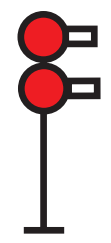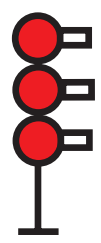Speaking Signaleze: Difference between revisions
Jump to navigation
Jump to search
No edit summary |
No edit summary |
||
| Line 22: | Line 22: | ||
|[[File:Signal Approach Yellow Red.png]] | |[[File:Signal Approach Yellow Red.png]] | ||
|[[File:Signal Approach Yellow Red Red.png]] | |[[File:Signal Approach Yellow Red Red.png]] | ||
|- | |||
|(Enough said?) | |||
|[[File:Signal Stop Red.png]] | |||
|[[File:Signal Stop Red Red.png]] | |||
|[[File:Signal Stop Red Red Red.png]] | |||
|} | |} | ||
</center> | </center> | ||
Revision as of 22:46, 22 August 2024
by Denis M. Larrick
From Modeltec, February 1991
Who among us has not at one time felt, if not totally ignorant, then at least selectively stupid when standing alongside the "big kids" tracks, attempting to decode the intentions of the signal department? Now, this is not a guide to the twenty zillion variations peculiar to individual railroads, but a simple list of the most common standard signals, providing that authentic aspects aren't beyond the average miniature coal-slinger and, in fact, could be quite practical and colorful along our tiny trials. There are only two simple rules to remember.
- Unless a signal is all red (meaning STOP), the color red is just a place keeper, saying, "don't look at me, stupid, look at the other lights!"
- American signals show speed, not routing. You will find out where you are going when you get there! If a mast has more than one head, the top head permits you normal rulebook speed. The second head restricts you to travelling "medium" speed (30 mph) ... may times (but not always) a diverging route through a switch. if a third head is used, it will indicate a slow speed (15 mph) route, such as a tight curve through a wye, a string of switches coming up, etc.
Not too tough, eh? Now let's jus pretend we're out on the high iron ...







